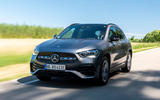Mercedes-Benz is not wasting any time adding new EQ Power badged plug-in hybrid models to its compact car line-up. So far, we’ve seen the A250e in both hatchback and saloon bodystyles and the B250e join the German car maker’s line-up in Britain. And now, after recent confirmation that the CLA 250e and CLA 250e Shooting Brake will also be sold here, we have this new petrol-electric model, the GLA 250e.
It’s still in a final phase of development, which is why Mercedes bills it as a prototype. But the plug-in hybrid crossover is planned for UK sale as a high-riding rival to the likes of the new BMW X2 xDrive25e later this year. It joins four petrol and diesel models in a new second-generation GLA line-up, offering an electric range that is put at between 33 and 38 miles on the WLTP test cycle – in the process endowing it with quite a favourable BIK rating for company car drivers.
The starting point for the GLA 250e is the new GLA 200. The two models share the same transversely mounted turbocharged 1.3-litre four-cylinder petrol engine – a unit developed in a joint venture between Mercedes-Benz parent company Daimler and Renault.
![]()
As in the GLA 200, the combustion engine develops 156bhp and 184lb ft of torque. But in combination with an electric motor delivering 101bhp and 221lb ft, the GLA 250e’s overall output is boosted to a combined 215bhp and 332lb ft – all channelled through an eight-speed dual-clutch gearbox to the front wheels.
There’s a bewildering array of driving modes, many of which the head of Mercedes’ compact car line-up, Jochen Eck, acknowledges will never be used by owners of the new model.
Electric mode serves up emission-free qualities, while a Battery Save setting allows you to operate the combustion engine to save the remaining battery charge for when you need it in low-emission zones and the like. There are also three hybrid modes - Comfort, Sport and Eco - and an Individual mode.
Inside, the GLA 250e is just like any other new GLA model, except the combustion engine doesn’t fire when you hit the starter button. Instead, it is programmed to start on the electric motor, so there’s no telltale exhaust noise of any kind as you set off. There are also some additional gauges within the digital instrument panel showing battery charge and electric range.




















Join the debate
Add your comment
Best
Best ever seen quickpay mode for this type great
The fact it has a fairly
The fact it has a fairly strong petrol engine and full gearbox still makes it look too much like a bolt-on-bits-tax-dodger with too much encouragement never to plug it in, especially company car drivers on a paid for fuel card. It will still put enough charge in the battery from the engine during off peak driving to give the full beans electric boost when needed even without ever seeing a mains charger. (BMW system the same)The Mitsubishi solution of leaving out the gearbox and using stronger motors to become the primary driving force and using the engine as an independent electrical generator (until direct coupled at speed) seems a more committed design approach. Its more like saying, lets build a short range EV with a range extender charger engine, than lets build a normal car with enough secondary propulsion system to get round the WLTP tests with a low tax figure.